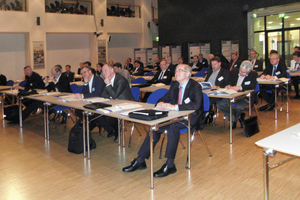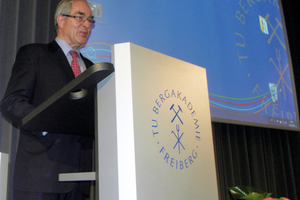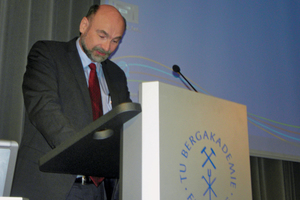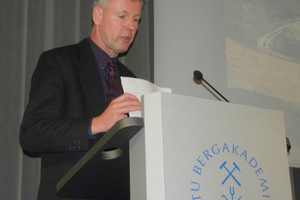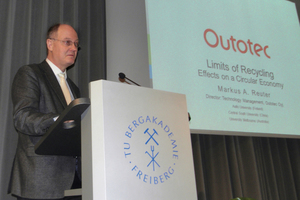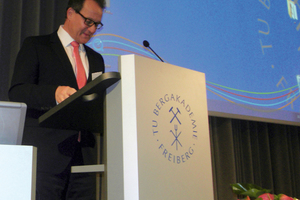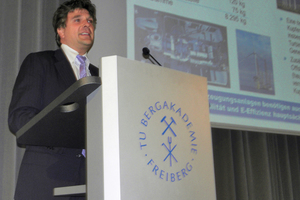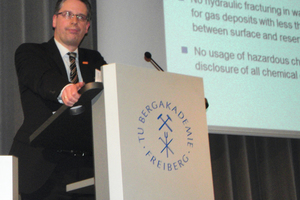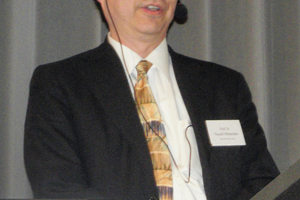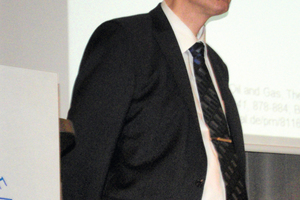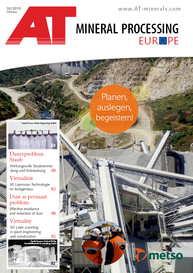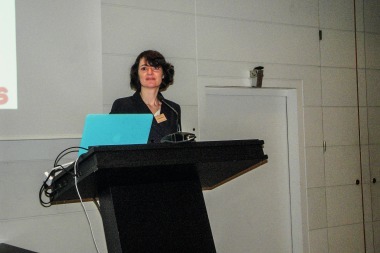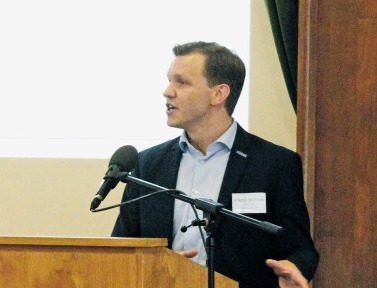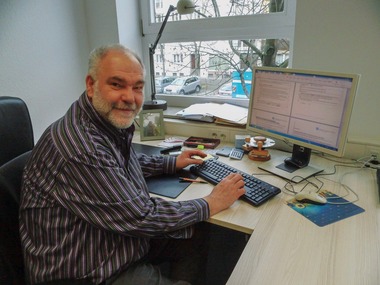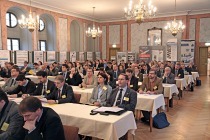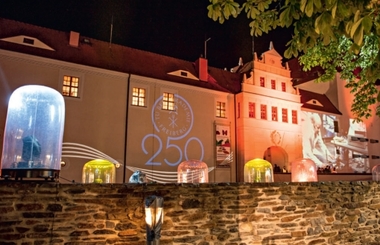5th Symposium Freiberg Innovations:
Energy and raw material challenges of the coming five decades
The Technische Universität Bergakademie Freiberg (TU BAF) in cooperation with the Helmholtz Institute Freiberg for Resource Technology (HIF) held the 5th Symposium “Freiberg Innovations” on March 25 and 26, 2015. The conference was aimed at highlighting goals, chances and risks – in particular under global aspects – of the medium and long-term challenges placed on the energy and raw material supply, at deriving measures from it and acquainting decision-makers with the results. The crucial question was: Which innovative technologies are capable of meeting the rising global demands for energy and raw materials and how can environmental protection be improved at the same time? While the bilingual event (English/German) with more than 50 participants was characterized by an almost informal atmosphere, several scientific representatives from abroad (Japan, Australia, USA, France, Finland) emphasized the global character of the topic. Therefore, this concentrated expertise and the wealth of ideas presented there would have deserved a broader audience.
In his address of welcome, Prof. Dr. Peter Kausch, TU BAF, took a look at the year 2050 and asked: „What will happen? If statistics are correct, the world population will have grown to 9 billion people by that time. This means, we will need more energy, food and natural resources. And this requires smart solutions”. Prof. Dr. Roland Sauerbrey, Scientific Director of the HIF put it more strongly: „How can we ensure, within the next 50 years, that mankind will survive on Earth?” Respective strategies need to be developed and the necessary innovations to be boosted. He underlined the unique possibility of Freiberg-Dresden as a scientific location to enforce the European strategy regarding resource conservation and energy turnaround, to ensure the use of raw materials and to bring about the energy turnaround. “The best energy is that which is generated in an ecological and environmentally friendly way worldwide”, so his credo.
In four thematic blocks, the latest research results of the TU BAF and the HIF were presented, supplemented by communications from some of the leading companies regarding their strategy of raw materials supply. Although attempts were made to bring out the main points, a proper delimitation turned out to be difficult. The recurring key issue concerned the safeguarding of raw materials and energy:
1. The future of resources and demography – global perspectives
2. Consequences for the resource base
3. Resource demand and related strategies
4. Limits of primary and secondary raw ma‑
terial sources
In his introduction, the presenter, Prof. Dr. Matschullat, TU BAF, emphasized that scientists had the responsible task to not only exchange their expertise among each other, but to include economy and politics as well as the general public to make everyone aware of the challenges facing mankind – even in case of a linear development, which however is rather unrealistic. These challenges and approaches to solutions ran like a thread through all the lectures.
Hans-Joachim Welsch, ROGESA Roheisengesellschaft Saar mbH, Dillingen, demanded a consistent strategic orientation towards the self-supply of raw materials and outlined a picture of the global struggle for raw ma‑
terials, which is in full swing. In addition to the improvement of the import situation (raw material partnerships), the increased use of domestic resources and the enhancement of resource efficiency, more intense recycling efforts are needed. “Recycling is indispensable for the safeguarding of the raw ma‑
terial supply, and already today, one fifth of the resources in Germany are covered by it,” explained the speaker and pointed to the important role of politics in securing the supply of raw materials, since Germany will depend on imports even in the future.
Quantified sustainability from design to recycling was called for by Prof. Dr. Markus Reuter (“Limits of recycling”). In future, the merely material-focused considerations common today should also embrace energy. Even though a completely closed cycle will never exist, there are still a lot of possibilities for system innovations. The energy turnaround in times of increasing energy demand was the topic of the lecture held by Prof. Dr. Nickolas T. Arndt, University of Toronto, Canada (“Metals for a low-carbon society”). Especially the production of metals is characterized by high energy demand (21 % of the global energy demand alone is attributable to steel and cement production). The transition to renewable energies causes a new problem: their production requires a large amount of strategic raw materials and also of basic metals (Cu, Zn, Al), steel and concrete. Here again, apart from the recovery of primary raw ma‑
terials, recycling is an important aspect. Covering a major part of the demand with domestic raw materials is not a utopian idea, because geological data show that there is potential in Europe itself, it is only that new methods of exploration and exploitation need to be applied. Based on broad argumentative public relations activities, the resistance against the exploration and exploitation of deposits can be counteracted. This is exactly the direction the research program of the Federal Government, “Research for Sustainability FONA 3”, which starts in 2015, is aiming at. With a volume of 200 million Euros and a duration of 10 – 15 years, its goal is the extension of the raw material base (e.g. the use of CO2 as a raw material) by increasing the domestic proportion, as the lecture of PD Dr. Lothar Mennicken, BMBF Berlin, showed.
The impacts of the energy turnaround, in particular on the energy-intensive industries, were the topic of Ulf Gehrckens, Aurubis AG Hamburg. Aurubis, Europe’s biggest producer of Cu and the biggest Cu recycler worldwide, has an energy demand across the group of about 1.8 billion kW/h of electricity and 1.3 billion kW/h of gas per year. About 40% of its production comes from recycling, one third of the production costs is attributable to energy costs, about 30% of which to environmental precautions. The current increase in electricity costs in Germany threatens, in particular, energy-intensive companies, since these local costs cannot be passed on customers, as is the case with other goods. Gehrckens advised against a German solo attempt concerning the reduction of CO2 (target: 40 % by 2020), since this would only lead to higher emissions in other EU countries. Convincing arguments brought him to say that the energy turnaround was not well-thought-out and premature and political statements were often exaggerated. “One kilowatt-hour that comes when it wants to is more expensive than one that comes when it is needed. Given the way this turnaround is designed, the German Cu-industry will not be able to win the race in the world market”, he critically commented.
As a representative of the world’s largest chemical company that runs its own raw material business, Gunther-Alexander
Kellermann, Energy & Climate Policy BASF, argued in a similar way. Raw material costs – basically caused by the main raw material Naphtha – are immense. The speaker illustrated the increasing pressure of competition on the German chemical industry taking into account the international price development and outlining considerations on further raw materials, such as shale gas and Chinese coal. Fracking – an interesting topic for BASF, but in Germany accompanied by hysterical debates. He, too, demanded that raw material and energy policy makers should establish a strategy under global aspects and provide for counter measures to safeguard the competitiveness of the European chemical industry.
Prof. Dr. Roderick Eggert, Colorado School of Mines/USA, reflected on critical raw materials, while taking into account a number of examples from the Bronze Age to the present, and on the reduction of the criticality (innovations in the field of substitution, recycling, increase in efficiency of production through interdisciplinary research).
Allister Mac Donald, Alkane Resources Ltd., South Wales/Australia, reported on rare earths and their application as well as on the possibility of their extraction from domestic raw materials.
Finally, Prof. Dr. Jens Gutzmer, HIF Freiberg, presented the Knowledge and Innovation Communities for the raw material sector, in particular the EIT (European Institute of Innovation and Technology), the first European initiative combining the three sides of the economic triangle – education – enterprise – research and development – and aiming at the systematic establishment of regionally embedded clusters and international networks.
On the second day of the conference, rare earths were under discussion, for example in the lecture by Prof. Dr. Yasushi
Watanabe, Akita University/Japan, who presented a solution for the domestic availability of SE-resources (by-product of the apatite production), or by Prof. Dudley J. Kingsnorth, Curtin Graduate School of Business, Perth/Australia, who went into chances and risks for the SE-industries in a global ecological economy. In his speech about SE for heavy-duty magnets, Prof. Dr. Oliver Gutfleisch, TU Darmstadt, dealt with the development of innovative materials and the substitution of these expensive raw materials and substances. Drastically reduced SE also came up as did the development of SE-free permanently magnetic and magnetocaloric materials (e.g. La-Fe-Si-based compounds) for use in the field of renewable energies (wind turbines, electric mobility).
A very interesting speech on the topic of “methanol technologies” was delivered by Prof. Dr. Martin Bertau, TU BAF, who accused politics of not providing a strategic concept for the required energy turnaround and of not giving adequate consideration to developments in science, with the consequence of missing great opportunities. Methanol, which can be generated from CO2 and water, is an all-rounder: it serves as fuel, energy and chemical raw material of the future, as impressively demonstrated by the speaker who referred to a pilot project run by the TU Essen-Duisburg along with Mitsubishi Hitachi Power Systems Europe in the STEAG power plants in Lünen.
Another forward-looking presentation entitled “Resource technologies 2065” was given by Prof. Holger Lieberwirth, TU BAF. Starting with the trend in resource consumption already mentioned before and the limited, increasingly depleted deposits, he went into the alternatives for resources, such as
extraterrestrial, maritime, planetary sources and asteroid capture as well as beaming of solar energy through space mirrors, from which he deduced trends in future extraction technologies.
Conclusion
“How will we meet the challenges of resource supply in the next 50 years to come?” asked Prof. Dr. Jörg Matschullat at the end of the Symposium and summarized what all the speeches of the two-day conference had shown: science comes up with excellent results which are a good basis for the achievement of the energy turnaround urgently required as well as for the securing of raw materials. What is needed is the long-term safeguarding for the benefit of the energy and extractive industry, to which however too little attention is paid. It is high time to give a realistic impetus to the energy turnaround and to smooth out wrong assumptions and their consequences, in particular with regard to the energy-intensive industry. The commitment of all entities involved is required to bring into the open the problem of an insufficient strategy for the energy turnaround and to provide remedial actions as quickly as possible.

